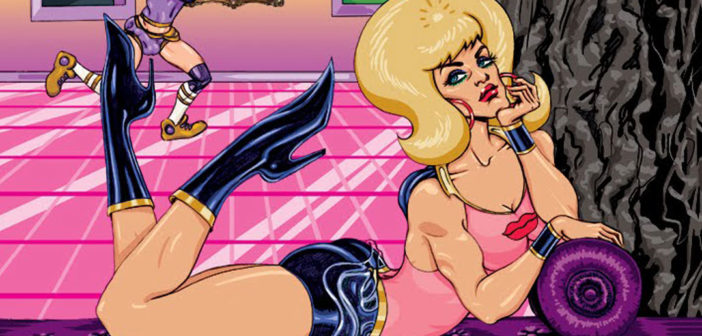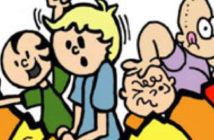Glamazonia: The Uncanny Super-Tranny, newly published by Northwest Press, is a book I approached with the best of intentions. In fact, I’m the one who solicited Northwest’s editor-in-chief, Charles “Zan” Christensen, for a review copy. But when I read the word “dahling” for the first time, I broke into a cold sweat. And by the time I finished the story, “J.F. Killer,” my fate was sealed: it was impossible for me to look past this transsexual superhero’s shrill ego. Glamazonia is no hero of mine—she’s Spider-Man to my Jonah Jamison.
Glamazonia’s character is one part RuPaul and another Superman, though I’m probably wrong on this. In a later chapter of Glamazonia, our hero (heroine?) changes her origin story to suit the particular man she is flirting with in a super-charged locker room. She first spouts off about her alien birthright originating from an entire planet populated by drag queens. To my dread, they all make tacky use of the word “dahling,” and rest assured, they use it a whole lot.
But the story eventually changes when the super-powered transsexual moves over to yet another man, taking on a predictable metamorphosis that mirrors the infamous transformation of young Bruce Wayne into Batman. And then it happens again, except this time Marvel’s pool is tapped and Spider-Man is borrowed from.
As such, Glamazonia’s origin is a bit of a mystery. But her personality is not: she’s not very likeable. I suspect, at least partially, that her character is intended to be a cheeky nod to the late Divine of John Waters fame, but she comes across more as a bitter and aging queen with a Chi Chi LaRue complex. Glamazonia finds herself embroiled in several sexual adventures; her love affair with John F. Kennedy is most worth a mention.
But the “J.F. Killer” story is all about Glamazonia showering glamour onto her own character—she has sex with J.F.K., is enraged when his presidential eye moves on to another piece of cross-dressing meat, and decides he must die for his prowling heart. Though, Glamazonia doesn’t pull the trigger in Dallas—another queen does.
It’s sounds as if I am taking this too seriously, that I can’t handle a joke. But jokes should elicit at least one laugh. I was rewarded with none. Glamazonia is a garishly illustrated and colored book, but with all of the life in its artwork, the messages in the stories never take off. If humor is the book’s intention, it fails. If there’s some other pearl of wisdom hidden in the pages, I have yet to discover it.
The book is a series of chapters featuring Glamazonia, such as “J.F. Killer,” and most of them are illustrated and written by creator Justin Hall. In between the main chapters are small, one-page entries that read like LGBT-oriented public service announcements. They too are written by Hall, but are drawn and colored by a wide assortment of artists, such as Steve MacIssac (Shirtlifter) and Edward Luce (Wuvable Oaf).
And I’d be remiss if I didn’t mention one extended story penciled and colored by Jon Macy titled “Rent Boy: Year One.” Macy uncanny channels the hard, angular noir lines of David Mazzucchelli’s legendary work on Batman: Year One. His artwork is a wonder to behold, but the story it’s framed around is once again a monument to Glamazonia’s obnoxious personality.
It’s no exaggeration that all roads paved by these stories lead back to Glamazonia and whether or not readers will like or hate her. Behind her faux bouffant, fake eyelashes, and pounds of eye shadow, I see nothing but a spirit of superficiality, and I’m just not sure what Hall’s intention is. I had hoped Glamazonia: The Uncanny Super-Tranny would communicate some kind of ever-present message or theme, but all it delivers is a celebration of ostentation and pettiness. And should those qualities be celebrated?
This comic book review originally appeared on Broken Frontier.




